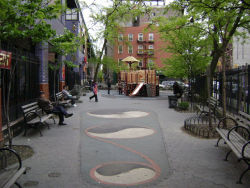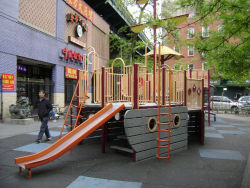Sophie Irene Loeb
Loeb Playground
Born in Russia, Sophie Irene Simon Loeb (1876-1929) immigrated with her family to the United States when she was six years old. Soon after settling in Pennsylvania, Loeb’s father, Samuel Simon, died, leaving the family with no means of support. As the eldest of the six children, sixteen-year-old Sophie was forced to work in a store to help her mother support their large family. These financial struggles prompted Loeb’s later concern for social reform and welfare.
After graduating from high school, Sophie began teaching grade school. In 1896, she married Anselm Loeb, a storeowner and her former employer. Marriage freed Sophie from teaching and allowed her to pursue other interests such as art, poetry, and writing. Her writing came to the attention of several publishers, including the editors and publishers of the New York Evening World. In 1910, Loeb moved to New York City after divorcing her husband. Keeping the name Loeb, she began working at the Evening World as a reporter.
Loeb turned her attention toward welfare for widowed mothers. New York City had struggled for years over the idea of civic versus state economic relief for “destitute mothers.” The city maintained homes for children of widowed mothers, but many women refused to send their children to these homes, leaving them to the mercy of private charities. Believing that private aid was insufficient, Loeb sought state relief as well. She wrote several articles that argued for the establishment of a state relief system, and worked closely with Hannah Bachman Einstein who founded the Widowed Mothers’ Fund Association in 1909. Elected President of the New York City Welfare Board in 1923, Loeb helped found the Child Welfare Committee of America in 1924. She also fought for immigrant use of New York City schools as civic centers, cleaning and fireproofing movie theaters, the installation of public baths, the funding school lunches, and support for housing reform.
Ten years after Loeb’s death, Congress amended the Social Security Act of 1935 to include provisions for the protection of widows and children of laborers. Although she died childless, Loeb nevertheless was known as the “godmother of American children.” Housing reformer and former Parks Commissioner August Heckscher donated a memorial in Central Park to Loeb in recognition of her work. The motif of the memorial comes from Lewis Carrol’s Alice in Wonderland.
The City acquired the land for this playground in 1924. In 1933, the Board of Aldermen named this playground after Loeb, citing her tireless efforts on behalf of the city’s children. Recent improvements to the playground include the planting of several London Plane trees (Platanus x acerifolia) and the addition of safety features to the existing play equipment. A tree known for its ability to survive in harsh urban environments, the London Plane takes its name from London, England. Due to the tree’s enduring popularity, Parks uses the silhouette of a London Plane leaf as its official insignia.
Check out your park's Vital Signs
Clean & Safe
Green & Resilient
Empowered & Engaged Users
Share your feedback or learn more about how this park is part of a
Vital Park System




